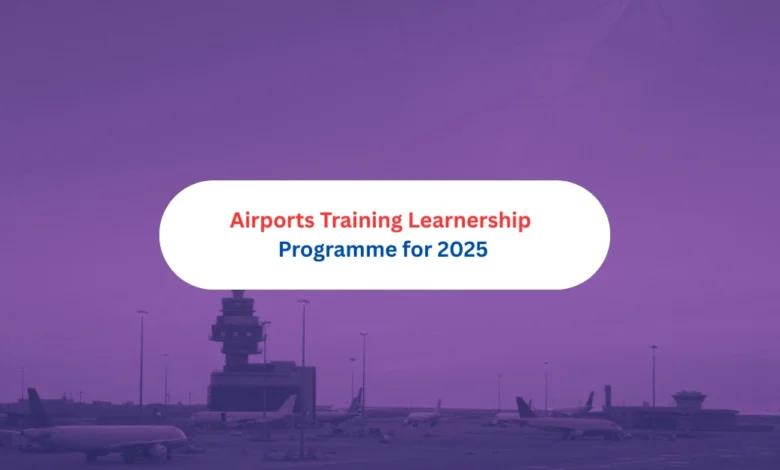Airports Training Learnership Programme for 2025: Your Gateway to a Career in Aviation

Airports are busy hubs that keep the world moving. From passenger flights to cargo shipping, airports play a key role in global growth. As the industry expands, so does the need for skilled workers. That’s where training learnerships come in—they help break down barriers and open doors to aviation careers. The 2025 Airports Training Learnership Programme offers a perfect chance for aspiring professionals to jumpstart their journey in this exciting field.
Overview of Airports Training Learnership Programmes
What Are Training Learnership Programmes?
Training learnerships blend real work experience with classroom learning. They are designed to give you practical skills and industry knowledge at the same time. Think of it as learning on the job while earning a qualification. In airports, learnerships cover areas like safety, customer service, and technical operations. These programmes prepare you to handle real challenges in the airport environment.
Benefits of Participating in the 2025 Programme
Taking part in the 2025 airports learnerships can boost your future. You gain skills that matter in the aviation field, making you more employable. You also get official certification that shows you’re ready for the job market. Plus, completing the programme opens doors to new career paths and advancement opportunities within the industry.
Key Stakeholders and Collaborators
The success of these programmes depends on many partners. Airports Authority, government agencies, and airlines work together to create the curriculum. Educational institutions also play a key role by providing training and certification. Industry partners ensure the programme stays relevant and up-to-date with current needs.
Eligibility Criteria and Application Process
Who Can Apply?
If you have a high school diploma or technical qualification, you’re likely eligible. Some programmes prefer candidates with good communication skills and teamwork qualities. Also, regional considerations often matter—some programmes prioritize specific areas or communities.
How to Apply
- For 2025, keep an eye out for application opening dates.
- Most programmes require you to submit a CV, a copy of your ID, and your academic results.
- Make sure your documents are up-to-date and tailored to the industry.
- START APPLICATIONS
- Preparing for interviews by researching the company helps you stand out.
Selection Process
Once applications close, the best candidates go through a screening. This might include written tests, group activities, and interviews. Selection factors include your skills, attitude, and how well you fit the programme’s needs. Being prepared and confident can make a big difference.
Key Components and Structure of the Programme
Core Training Areas Covered
Participants learn about ground operations, security procedures, customer service, and aircraft maintenance. Some programmes include air traffic control basics. Experts teach industry-specific skills that prepare you for a wide range of roles at airports.
Duration and Learning Modules
Most learnerships last between 12 to 24 months. They’re divided into modules that focus on different skills. The first phase might cover safety and customer service, followed by technical training. The last stage involves hands-on work experience.
Practical Work Placements
Real-world training is a vital part of the programme. You’ll work at partner airports or related organizations. This on-the-job experience helps you see what works and what doesn’t in real situations. You gain confidence working alongside seasoned professionals.
Career Opportunities Post-Programme
Job Roles and Specializations
After completing the learnership, possibilities include working as a baggage handler, security officer, ground staff, or maintenance technician. Many graduates move into supervisory roles as they grow their skills. Some may specialize in areas like airport security or aircraft repair.
Industry Demand and Future Outlook
The aviation industry continues to grow. Statistics from IATA and KTMCA show jobs increasing yearly, both regionally and internationally. This trend means more chances for trained professionals. The future looks bright for those with proper training and certifications.
Industry Quotes and Expert Insights
Graduates from previous programmes often share how it changed their lives. Industry leaders emphasize the importance of structured training to meet rising demand. Experts agree that airport training programmes are essential for building a talented workforce.
Tips for Success and Making the Most of the Learnership
Preparation Tips Before Applying
Research the airport you want to work at. Try to gain basic skills like communication or customer service. Volunteering or part-time work can give you a taste of airport life. The better prepared you are, the higher your chances of success.
During the Programme
Stay engaged and eager to learn. Ask questions and seek feedback from trainers. Building relationships with mentors and peers helps your future career. Remember, every task is a chance to grow.
After Completion
Keep developing your skills through workshops or additional training. Use your certification to find new jobs or promotions. Networking within the industry can open doors to opportunities you might not expect.
Conclusion
The 2025 Airports Training Learnership Programme stands as a vital step for anyone dreaming of a career in aviation. It offers real skills, industry recognition, and job prospects that can last a lifetime. If you’re ready to step into a fast-paced, exciting world, this programme is your launchpad. Stay informed about application dates and start preparing now—your future in aviation could be just around the corner.





